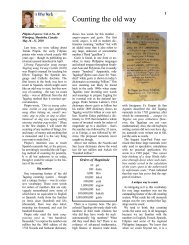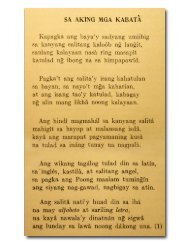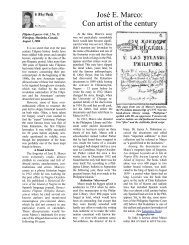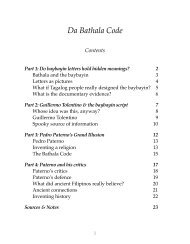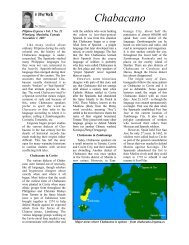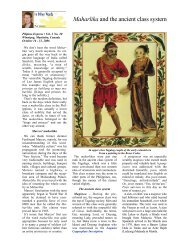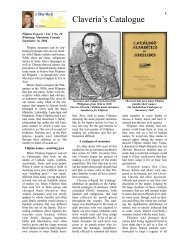100416 Last laugh Jo.. - Pilipino Express
100416 Last laugh Jo.. - Pilipino Express
100416 Last laugh Jo.. - Pilipino Express
You also want an ePaper? Increase the reach of your titles
YUMPU automatically turns print PDFs into web optimized ePapers that Google loves.
<strong>Last</strong> <strong>laugh</strong> for <strong>Jo</strong>se Marco<br />
Walang manloloko kung walang magpapaloko<br />
1<br />
<strong>Pilipino</strong> <strong>Express</strong> • Vol. 6 No. 8<br />
Winnipeg, Manitoba, Canada<br />
April 16 - 30, 2010<br />
<strong>Last</strong> month, I attended the Association<br />
for Asian Studies annual<br />
meeting in Philadelphia where literally<br />
hundreds of panels discussed<br />
hundreds of academic papers. Unfortunately,<br />
very few of them were<br />
about the Philippines. The conference<br />
did, however, give me an opportunity<br />
to meet some of the top<br />
specialists in the field of Philippine<br />
Studies. One of them was Dr. Michael<br />
Salman, an Associate Professor<br />
at UCLA who presented a paper<br />
on Maria Rosa Henson, one of the<br />
sex slaves or “comfort women” as<br />
they were known during the Japanese<br />
occupation of the Philippines<br />
in World War II. As heart wrenching<br />
as her story was, it was not the<br />
only reason I wanted to meet Professor<br />
Salman. I wanted to pick his<br />
brain about one of my favourite<br />
shadowy figures in Philippine history<br />
– <strong>Jo</strong>se E. Marco.<br />
Marco was the hoaxer who, in<br />
1913, concocted the fictitious Datu<br />
Kalantiaw and his brutal, but<br />
equally fictitious, legal code of<br />
1433. He also made countless other<br />
forgeries until the 1960s that still<br />
afflict Philippine society and school<br />
textbooks. (See my articles listed<br />
below.)<br />
<strong>Last</strong> year, Michael Salman contributed<br />
two chapters to the book<br />
Colonial Crucible, edited by Alfred<br />
McCoy and Francisco Scarano<br />
(2009). One of the chapters, “Confabulating<br />
American Colonial<br />
Knowledge in the Philippines,”<br />
concerns <strong>Jo</strong>se Marco and his<br />
frauds. I managed to corner Dr.<br />
Salman after his presentation,<br />
while on his way to check out of<br />
the hotel, and he kindly spared me<br />
a few minutes.<br />
The swindler and his suckers<br />
For Salman, Marco is a kind of<br />
“trickster hero,” in the literary<br />
sense and simply debunking his<br />
frauds is secondary compared to<br />
understanding how and why the<br />
frauds became so successful in the<br />
first place. To this end, Salman<br />
focused his attention on the American<br />
academics who believed<br />
Marco’s fakes to be real and promoted<br />
them for decades, even as<br />
the evidence of Marco’s fraudulence<br />
was piling up.<br />
“I think it is time for us to rewrite<br />
the story so that <strong>Jo</strong>se E.<br />
Marco enjoys the last <strong>laugh</strong>,” wrote<br />
Salman in his essay.<br />
I mentioned some of these<br />
American supporters of the Marco<br />
fakes in my articles, but Salman<br />
was able to dig deeper by reexamining<br />
their published statements<br />
and their private letters about<br />
<strong>Jo</strong>se Marco, as well as their correspondence<br />
with him. Many of these<br />
letters and other primary documents<br />
are kept in the University of<br />
Chicago Library and the Newberry<br />
Library in Chicago.<br />
<strong>Jo</strong>se Marco’s first and most<br />
valuable American supporter was<br />
the Director of the Philippine National<br />
Library, Dr. James Alexander<br />
Robertson, who called Marco “a<br />
good friend to the institution” and<br />
his earliest contributions, “the greatest<br />
literary discovery ever made in<br />
the archipelago.” He also wrote<br />
English translations of Marco’s fake<br />
documents and sent one of them to<br />
the 1915 Panama-Pacific Historical<br />
Congress in California.<br />
To this day, there are people who<br />
still believe that Marco’s so-called<br />
discoveries are true, even though<br />
they were soundly debunked more<br />
than 40 years ago. Michael Salman’s<br />
position is that blaming Marco alone<br />
for the havoc these fakes caused in<br />
the field of Philippine historiography<br />
misses the point. He wrote,<br />
“Marco did make such contributions<br />
but only because there was a willing<br />
market and audience. Looked at<br />
from this angle, it is more proper to<br />
speak of Robertson’s contributions<br />
to Philippine historiography than<br />
Marco’s.”<br />
In the 1950s, the University of<br />
Chicago’s Philippine Studies Program<br />
published new translations of<br />
Robertson’s collection of Marco<br />
fakes as well as a new batch of<br />
forgeries they had received from<br />
Dr. Michael Salman<br />
Marco himself. According to Salman,<br />
the directors of the program,<br />
Fred Eggan and Evett D. Hester,<br />
“spent an enormous amount of time<br />
seeking help from experts and people<br />
in the field to verify the authenticity<br />
of these documents … Their<br />
correspondence about the Marco<br />
manuscripts is simply incredible to<br />
read for it reveals a stubborn conviction<br />
about the authenticity and<br />
importance of the early Povedano<br />
and Pavón manuscripts [Marco<br />
forgeries], the kind of unshakeable<br />
faith in a seemingly obvious falsehood<br />
that would make George W.<br />
Bush proud.”<br />
The jig is up but who’s to blame<br />
Meanwhile, Mauro Garcia, a<br />
Filipino scholar and book collector,<br />
had serious doubts about the<br />
authenticity of the Marco documents.<br />
As early as 1956 he tried to<br />
convince one of Fred Eggan’s students,<br />
Robert Fox, that he should<br />
be “extremely suspicious” of<br />
Marco. Fox then wrote to Hester<br />
saying that, as Salman related, “he<br />
thought that Hester and Eggan<br />
should consider the possibility that<br />
‘Marco is a kind of genius who is<br />
fabricating the manuscripts in their<br />
entirety.’” In hindsight, this statement<br />
is hilarious, considering the<br />
extreme crudity of Marco’s forgeries<br />
and the ludicrous historical errors<br />
they contained. (Again, see my<br />
articles listed below.)
Paul Morrow • In Other Words • The <strong>Pilipino</strong> <strong>Express</strong> • April 16 - 30, 2010<br />
2<br />
At a meeting of the Bibliographical<br />
Society of the Philippines<br />
in 1959, Mauro Garcia presented<br />
what Salman described as “devastating<br />
internal evidence that all of the<br />
Povedano manuscripts were frauds<br />
and that Marco dealt in other<br />
fraudulent items, especially stamps.”<br />
Yet, Eggan and Hester continued to<br />
insist after 1960 that Marco’s early<br />
alleged discoveries were real, even<br />
though they were suspicious of his<br />
recent offerings.<br />
Garcia was the first person to<br />
expose <strong>Jo</strong>se Marco as a fraud but, as<br />
Salman put it, Garcia was not “at the<br />
centre of authority.” So, taking a page<br />
from Marco’s own playbook, Garcia,<br />
a Filipino, used the authority of an<br />
American to get his message taken<br />
seriously. Garcia approached William<br />
H. Scott, a doctoral candidate at the<br />
University of Santo Tomas, and suggested<br />
that he write his dissertation<br />
on the sources used in the study of<br />
the pre-Hispanic Philippines, likely<br />
hoping that Scott would eventually<br />
discover for himself the full extent of<br />
Marco’s frauds.<br />
Today, William H. Scott is generally<br />
credited for exposing Marco’s<br />
hoaxes while Mauro Garcia has<br />
been relegated to the footnotes.<br />
Scott was apparently unaware that<br />
Garcia had been trying to expose<br />
Marco’s pre-colonial fakes for more<br />
than ten years before he started work<br />
on his dissertation. In that dissertation,<br />
which was published in 1968 as<br />
Prehispanic Source Materials for the<br />
Study of Philippine History, Scott<br />
quoted some of Marco’s correspondence<br />
with Eggan and Hester at the<br />
University of Chicago, but he never<br />
took the Americans to task, like Salman<br />
has done. Perhaps the fact that<br />
Marco had passed away in 1963<br />
while Eggan and Hester were still<br />
alive and at the centre of authority,<br />
supporting Robertson’s legacy, was<br />
a factor in Scott keeping his sights<br />
trained on Marco’s forgeries. However,<br />
in Scott’s defence, he might<br />
have also felt that an indictment<br />
against Marco’s unwitting (or wilfully<br />
ignorant) accomplices was<br />
outside the scope of his examination<br />
of source materials.<br />
“In his treatment of <strong>Jo</strong>se E.<br />
Marco,” wrote Salman, “Scott gets<br />
all his facts right about the Marco<br />
manuscripts but makes the mistake<br />
of dismissing Marco and making<br />
only a simply diatribe against the<br />
fake.” Later in the essay, Salman<br />
added: “William Henry Scott, rest<br />
his dear soul, got it wrong when he<br />
sardonically titled his chapter, “The<br />
Contributions of <strong>Jo</strong>se E. Marco to<br />
Philippine Historiography.” It wasn’t<br />
Marco’s fault that Robertson was<br />
such a sucker, and we have only<br />
begun to try to analyze, rather than<br />
dismiss, Marco’s contributions.”<br />
The whole affair brings to mind<br />
the Filipino saying, walang manloloko<br />
kung walang magpapaloko –<br />
there are no swindlers without<br />
suckers.<br />
Sources and other reading:<br />
Michael Salman, “Confabulating<br />
American Colonial Knowledge<br />
of the Philippines, What the Social<br />
Life of <strong>Jo</strong>se E. Marco’s Forgeries<br />
and Ahmed Chalabi Can Tell Us<br />
about the Epistemology of Empire”<br />
in Colonial Crucible, Empire in the<br />
Making of the Modern American<br />
State, edited by Alfred W. McCoy<br />
and Francisco A. Scarano (2009)<br />
William H. Scott, Prehispanic<br />
Source Materials for the Study of<br />
Philippine History (1984 edition)<br />
Paul Morrow, <strong>Jo</strong>se E. Marco:<br />
Con man of the century (2006)<br />
www.pilipino-express.com<br />
Paul Morrow, Kalantiaw, the<br />
hoax (revised 2002)<br />
www.mts.net/~pmorrow<br />
E-mail the author at:<br />
feedback@pilipino-express.com or<br />
visit www.mts.net/~pmorrow for<br />
more about Filipino history and<br />
language.



